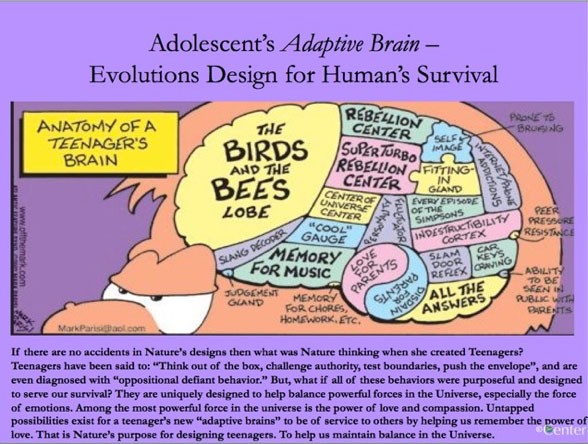There are no accidents in nature’s designs. Evolution tends to move towards balance and aids the survival of life forms and entities that exist towards that end. So, what is the purpose of adolescence?
Our orientation in youth & community development through rites of passage recognizes reciprocity between the transformation processes that occur during adolescence with those occurring within their parents. The potential for a “collision of transitions” between adolescence and mid-life is at hand. These transitional periods also have implications for change and transformation in one’s family, community, in relationship with their culture/ancestors, spirit and the natural world in which one lives. What might be possible if instead of our narrow focus on teenagers as if they are inherently a problem that needs to be fixed, they actually were designed by evolution to hold the keys to our survival and the future? The Planetarium Initiatory Event® PIE® explores this orientation and the potential that exists if we employ adolescences in this way.
Alison Gopnik and Tom Griffiths offers support for this idea that the period of adolescence has untapped potential. In his article for the Sunday Review: What Happens to Creativity as We Age? Gopnick and Griffiths (G&G) writes:
“Why does creativity generally tend to decline as we age? One reason may be that, as we grow older, we know more. That’s mostly an advantage, of course. But it also may lead us to ignore evidence that contradicts what we already think. We become too set in our ways to change.
Relatedly, the explanation may have to do with a tension between two kinds of thinking: what computer scientists call exploration and exploitation. When we face a new problem, we adults usually exploit the knowledge about the world we have acquired so far. We try to quickly find a pretty good solution that is close to the solutions we already have. On the other hand, exploration — trying something new — may lead us to a more unusual idea, a less obvious solution, a new piece of knowledge. But it may also mean that we waste time considering crazy possibilities that will never work, something both preschoolers and teenagers have been known to do.
This idea suggests a solution to the evolutionary paradox that is human childhood and adolescence. We humans have an exceptionally long childhood and prolonged adolescence. Why make human children so helpless for so long, and make human adults invest so much time and effort into caring for them?
The answer: Childhood and adolescence may, at least in part, be designed to resolve the tension between exploration and exploitation. Those periods of our life give us time to explore before we have to face the stern and earnest realities of grown-up life. Teenagers may no longer care all that much about how the physical world works. But they care a lot about exploring all the ways that the social world can be organized. And that may help each new generation change the world.”
One only has to Google adolescent discoveries to substantiate what G&G’s is talking about. In fact, it should be part of “best-practice” in every scientific laboratory and endeavor to include teenagers. Their out of the box proclivity and talent would open doors to new possibilities unimaginable to the mind stuck in “exploiting” old ideas and methods.
Community oriented rites of passage were our primal ways to exploit this powerful adolescent capacity. Recently neuroscientists have even discovered that the adolescent brain is different from that of a young child and adult. If you’ve ever parented, hung around or worked with teenagers for very long you’d know this to be obvious. They call the teenage brain the “Adaptive Brain” for the very reason the we all know and G & G writes. They continually test boundaries and yearn to experiment and experience the world on their own terms.
“The secret of change is to focus all of your energy
not on fighting the old, but on building the new.”
Socrates
Click here to read the full article by Alison Gopnik and Tom Griffiths
For more information on community-oriented rites of passage visit: www.rope.org. To find out more about how to make and serve PIE to nourish life and become part of changing the story to transform the future visit: www.PIEvent.org

♥ ©- Copyright David G. Blumenkrantz. In the spirit of reciprocity please share freely with attribution.
Posted in PIEIt’t time for a Paradigm Shift – a fundamental change in beliefs, theory and approach – in developing community-centered responses to the challenges faced by today’s Youth & Community. More here>>